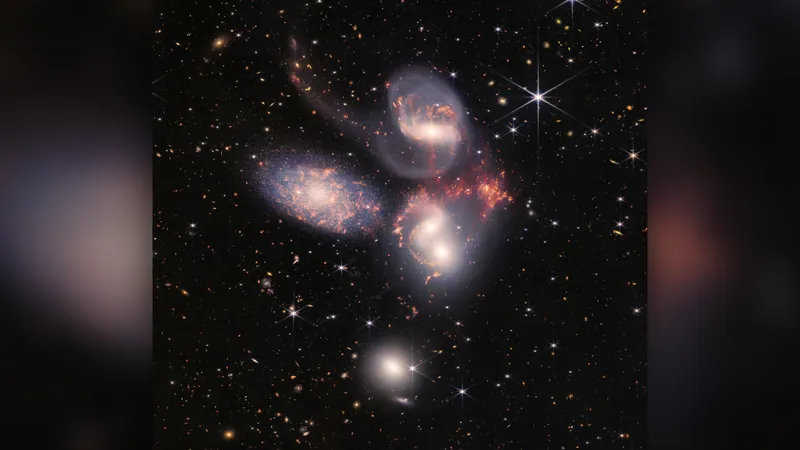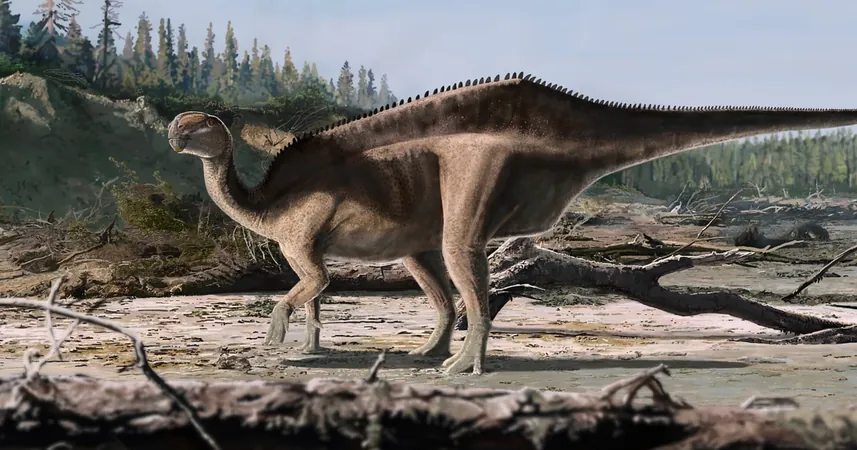
Unveiling Cosmic Chaos: James Webb Telescope Spots Rarer-Than-Rare 5-Galaxy Collision from the Dawn of Time!
2025-09-03
Author: Nur
A Cosmic Discovery Like No Other
In an astonishing find that shakes up our understanding of the universe, astronomers have unveiled a captivating spectacle: a merger involving at least five galaxies, dating back to just 800 million years after the Big Bang! This groundbreaking revelation sprung from the powerful gaze of the James Webb Space Telescope (JWST) alongside the iconic Hubble Space Telescope.
What Makes This Discovery Extraordinary?
Galactic mergers are crucial for the formation of galaxies, yet witnessing such events is a rarity, especially involving multiple galaxies. Dubbed the 'JWST's Quintet', this newly identified cluster boasts five galaxies and an impressive 17 additional galaxy clumps intertwined in a cosmic dance.
Weida Hu, the lead author of the study and postdoctoral researcher at Texas A&M University, succinctly stated, "Finding a system with five physically connected galaxies is exceptionally rare, making our detection feel almost like winning the cosmic lottery!"
The Secrets Hidden in the Stars
These galaxies have a unique identity as 'emission-line galaxies', revealing brilliant signals in their light that are indicative of new star formation, particularly marked by hydrogen and oxygen emissions.
Combining Forces: JWST Meets Hubble
Published in the journal Nature Astronomy on August 15, the research utilized a potent blend of data from both JWST and Hubble. Remarkably, JWST’s Near-Infrared Camera (NIRCam) revealed a massive halo of gas surrounding these galaxies, confirming their physical connection and collective identity.
An Unprecedented Galactic Network
While some galaxies were previously identified by Hubble, Hu emphasized that only JWST could establish that these five galaxies share the same redshift, indicating they're in a cosmic tangle. Redshift, a crucial cosmic measurement, stretches the light of distant objects, revealing their ancient origins.
A Celestial Comparison: Finding Cousins in the Cosmos
Interestingly, this quintuplet mirrors a more familiar group, Stephan's Quintet, found nearby in the universe. However, JWST's Quintet shines with higher activity due to an abundance of gas fueling star formation, suggesting a vigorous cosmic life that early galaxies experienced.
Cosmic Evolution: What Lies Ahead?
This captivating merger, with a collective mass equivalent to 10 billion suns, raises questions about its future. Will these energetic star-forming entities become quiet, 'dead' galaxies over time? The interplay of their black holes could hold the key to an explosive conclusion, potentially extinguishing their lively star formation.
The Bigger Picture: Understanding Galaxy Evolution
As we seek to uncover more systems like JWST's Quintet in upcoming surveys, researchers will be able to assess how often these galactic mergers occur and under what cosmic conditions they thrive. This research could redefine our theories about how galaxies evolve in the universe—a thrilling prospect for the next frontier in astrophysics!
Join the Journey!
With each discovery, we peel back the layers of the universe’s history, revealing not just the mechanics of cosmic formations but also the breathtaking beauty of the celestial tapestry. The revelations from JWST invite everyone to marvel at the universe's wonders and fuel our quest for knowledge about our cosmic origins.




 Brasil (PT)
Brasil (PT)
 Canada (EN)
Canada (EN)
 Chile (ES)
Chile (ES)
 Česko (CS)
Česko (CS)
 대한민국 (KO)
대한민국 (KO)
 España (ES)
España (ES)
 France (FR)
France (FR)
 Hong Kong (EN)
Hong Kong (EN)
 Italia (IT)
Italia (IT)
 日本 (JA)
日本 (JA)
 Magyarország (HU)
Magyarország (HU)
 Norge (NO)
Norge (NO)
 Polska (PL)
Polska (PL)
 Schweiz (DE)
Schweiz (DE)
 Singapore (EN)
Singapore (EN)
 Sverige (SV)
Sverige (SV)
 Suomi (FI)
Suomi (FI)
 Türkiye (TR)
Türkiye (TR)
 الإمارات العربية المتحدة (AR)
الإمارات العربية المتحدة (AR)